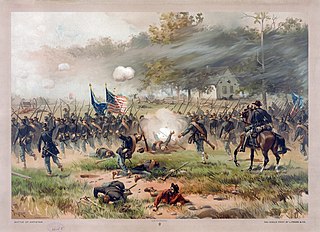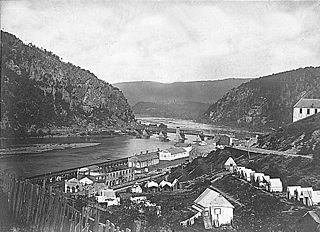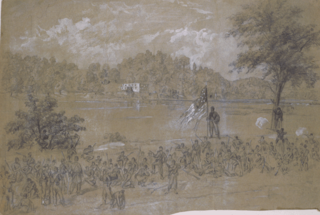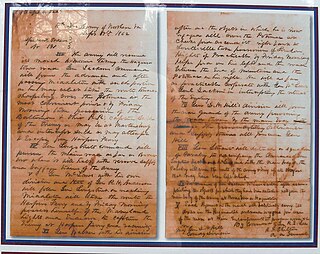Related Research Articles

The Battle of Antietam, also called the Battle of Sharpsburg, particularly in the Southern United States, took place during the American Civil War on September 17, 1862, between Confederate General Robert E. Lee's Army of Northern Virginia and Union Major General George B. McClellan's Army of the Potomac near Sharpsburg, Maryland, and Antietam Creek. Part of the Maryland Campaign, it was the first field army–level engagement in the Eastern Theater of the American Civil War to take place on Union soil. It remains the bloodiest day in American history, with a tally of 22,727 dead, wounded, or missing on both sides. Although the Union Army suffered heavier casualties than the Confederates, the battle was a major turning point in the Union's favor.

The Battle of Harpers Ferry was fought September 12–15, 1862, as part of the Maryland Campaign of the American Civil War. As Confederate Army General Robert E. Lee's Confederate army invaded Maryland, a portion of his army under Major General Thomas J. "Stonewall" Jackson surrounded, bombarded, and captured the Union garrison at Harpers Ferry, Virginia.

The Battle of Glendale, also known as the Battle of Frayser's Farm, Frazier's Farm, Nelson's Farm, Charles City Crossroads, New Market Road, or Riddell's Shop, took place on June 30, 1862, in Henrico County, Virginia, on the sixth day of the Seven Days Battles of the American Civil War.

The Battle of Shepherdstown, also known as the Battle of Boteler's Ford, took place September 19–20, 1862, at Boteler's Ford along the Potomac River, during the Maryland campaign of the American Civil War. After the Battle of Antietam on September 17, General Robert E. Lee and the Confederate Army of Northern Virginia withdrew across the Potomac. Lee left a rear guard commanded by Brigadier General William N. Pendleton at Boteler's Ford. On September 19, elements of the Union V Corps dueled with Pendleton's artillery before pushing a short distance across the river at dusk. Pendleton inaccurately informed Lee that all of the artillery of the rear guard had been captured. On the morning of September 20, the Confederates counterattacked with A. P. Hill's Light Division, forcing the Union units back across the Potomac. One Union unit, the 118th Pennsylvania Infantry Regiment, did not withdraw at the same time as the others and suffered heavy losses. Lee's army continued its retreat into the Shenandoah Valley after the battle.

The Maryland campaign occurred September 4–20, 1862, during the American Civil War. The campaign was Confederate General Robert E. Lee's first invasion of the North. It was repulsed by the Army of the Potomac under Maj. Gen. George B. McClellan, who moved to intercept Lee and his Army of Northern Virginia and eventually attacked it near Sharpsburg, Maryland. The resulting Battle of Antietam was the bloodiest day of battle in American history.

Special Order 191, also known as the "Lost Dispatch" and the "Lost Order", was a general movement order issued by Confederate Army General Robert E. Lee on about September 9, 1862, during the Maryland Campaign of the American Civil War. A lost copy of this order was recovered on September 13 by Union Army troops in Frederick County, Maryland, and the subsequent military intelligence gained by the Union played an important role in the Battle of South Mountain and Battle of Antietam.
The following Union Army units and commanders fought in the Second Battle of Bull Run, also known as the Second Battle of Manassas, of the American Civil War. The Confederate order of battle is listed separately. Order of battle compiled from the army organization during the battle, the casualty returns and the reports.
The following Confederate States Army units and commanders fought in the Second Battle of Bull Run, called the Second Battle of Manassas by Confederate records, of the American Civil War. The Union order of battle is listed separately. Order of battle compiled from the army organization during the battle, the casualty returns and the reports.
The following Union Army units and commanders fought in the Battle of Antietam of the American Civil War. The Confederate order of battle is listed separately. Order of battle compiled from the army organization during the Maryland Campaign, the casualty returns and the reports.
The following Confederate States Army units and commanders fought in Virginia's Battle of Chancellorsville, which lasted from April 30 to May 6, 1863, during the American Civil War. The Union order of battle is listed separately. Order of battle has been compiled from the army organization during the campaign, the casualty returns and the reports.

Hampton's Legion was an American Civil War military unit of the Confederate States of America, organized and partially financed by wealthy South Carolina planter Wade Hampton III. Initially composed of infantry, cavalry, and artillery battalions, elements of Hampton's Legion participated in virtually every major campaign in the Eastern Theater, from the first to the last battle.
The following Confederate States Army units and commanders fought in the Battle of the Wilderness of the American Civil War. The Union order of battle is listed separately. Order of battle compiled from the army organization May 5–6, 1864, the army organization at beginning of the Campaign, the army organization during the Campaign and the reports.
The following Confederate States Army units and commanders fought in the Battle of Spotsylvania Court House of the American Civil War. The Union order of battle is listed separately. Order of battle compiled from the army organization May 7–12, 1864, army organization May 13–25, 1864, the army organization during the Campaign and the reports.
The following Confederate States Army units and commanders fought in the Battle of Cold Harbor of the American Civil War. The Union order of battle is listed separately. Order of battle compiled from the army organization during the battle and the reports.
The following Confederate States Army units and commanders fought in the Seven Days Battles of the American Civil War. Order of battle compiled from the army organization during the battle, the casualty returns and the reports. The Union order of battle is listed separately.
Allen Sherrod Cutts was a Mexican-American War veteran who served as a colonel of artillery in the American Civil War, fighting for the Confederacy.
The following Confederate Army units and commanders were the initial structure on April 30, 1862 of the Confederate Army of Northern Virginia during the Peninsula campaign of the American Civil War. It contains units throughout Virginia that influenced the campaign. The Union order of battle is listed separately.

The Donaldsonville Louisiana Artillery was a Louisiana artillery unit that fought in the Confederate States Army during the American Civil War. Formed from an old militia company, it arrived in the Eastern Theater of the American Civil War in September 1861 with three obsolete guns and was equipped with three additional rifled guns. The battery fought at Yorktown, Williamsburg, Seven Pines, Gaines' Mill, Glendale, Second Bull Run, Antietam, Shepherdstown and Fredericksburg in 1862. The following year the unit served at Gettysburg and in the Bristoe and Mine Run campaigns. The battery fought in the Overland campaign and at the Siege of Petersburg in 1864. It surrendered at Appomattox in April 1865.

The Madison Louisiana Light Artillery was a Louisiana artillery unit that fought in the Confederate States Army during the American Civil War. Formed as an infantry company, it arrived in the Eastern Theater in May 1861 and was converted to an artillery battery in August. The unit was armed with six guns in 1861, but by September 1862, it had only four guns. It served at Garnett's and Golding's Farm, Savage's Station, Second Bull Run, Antietam, and Fredericksburg in 1862. The battery fought at Chancellorsville and Gettysburg and in the Knoxville campaign in 1863. The Madison Light Artillery served in the Overland campaign and at the Siege of Petersburg in 1864. The unit surrendered at Appomattox in April 1865.

The South Carolina Palmetto Sharpshooters were a Confederate sharpshooter unit in the American Civil War. The regiment served with the Army of Northern Virginia from 1862 to 1865. The unit would fight in most of the major battles in the eastern theater, and experience hard fighting in the western theater with James Longstreet in 1863.
References
- Antietam National Battlefield
- Sears, Stephen W., Landscape Turned Red: The Battle of Antietam. Boston: Houghton Mifflin, 1983. ISBN 978-0-618-34419-2.
- Sibley, Jr., F. Ray, The Confederate Order of Battle, Volume 1, The Army of Northern Virginia, Shippensburg, Pennsylvania, 1996. ISBN 0-942597-73-7
- U.S. War Department, The War of the Rebellion: a Compilation of the Official Records of the Union and Confederate Armies, U.S. Government Printing Office, 1880–1901.